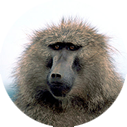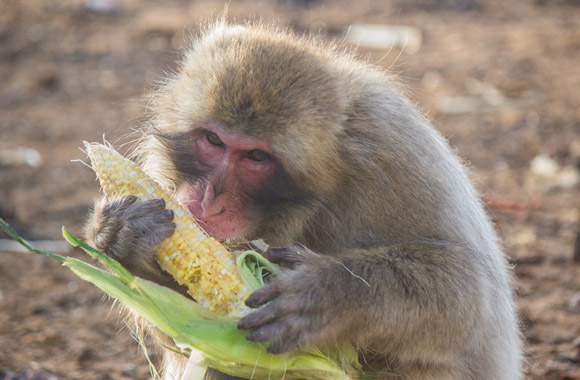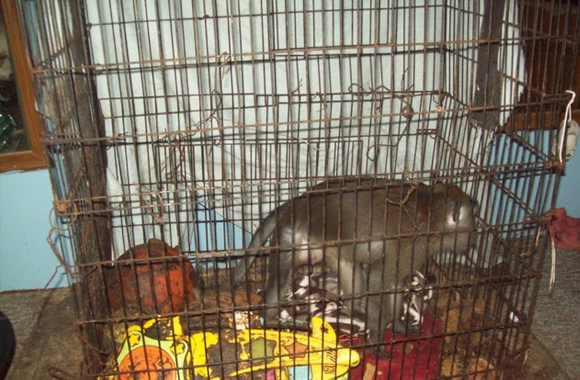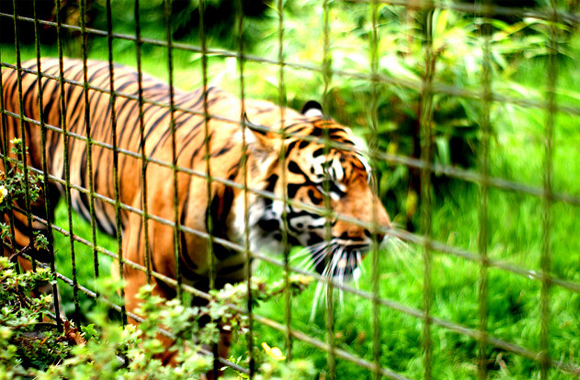Adopt a Baboon!
Sponsor one of the rescued baboons or other monkeys at the Born Free USA Primate Sanctuary!
Baboons
Baboons are largely ground-dwelling animals who have a varied diet that includes fruit, roots, and grubs and other insects. Most wild baboons live in hierarchical “troops” of five to 200 or more animals which are based on a core of females and juveniles, and may include several transient males. Male baboons leave their birth group, usually around puberty, whereas females stay in the same group their whole lives. Their lifespan is typically 20-30 years, but they can live up to 40 years.
Male baboons are powerful fighters, showing little fear of larger animals, and have been known to attack leopards. Visual communication is important to deter both attacks from predators and fighting among male baboons. They have many signals to communicate threat and dominance, including intense staring, flashing of the eyelids, ground slapping, chewing, tooth grinding, yawning and baring their canine teeth, eyebrow raising, ear flattening, and shaking of rocks and branches. They also make more than 30 unique vocalizations, including barks and screams.
Females typically give birth every other year, usually to a single infant after a six-month gestation. While the mother tends to be the primary caregiver, several females will share caring duties.
Baboons are notable not only for their distinct looks, but also for their unique personalities. Two of the most endearing characters at the 175-acre Born Free USA Primate Sanctuary are Buddy Holly and Elvis Presley: young male baboons who seem to have a never-ending supply of energy. The Sanctuary, located near San Antonio, Texas, is home to approximately 475 primates (baboons, macaques, and vervets). While the majority of the inhabitants are macaques, a couple dozen baboons also call our sanctuary home. In 2013, nine female baboons, to whom we refer as the Lucky Nine, were retired to the sanctuary from a research facility. They spent their entire lives in research, some for as long as 23 years, where they never had access to the world outside, much less grass under their feet. Today, they enjoy the relative freedom that our sanctuary offers.
The conventional thinking is that there are five subspecies of baboons (though there is controversy about the taxonomic classification of baboons, particularly because interbreeding is common): anubis (or olive), yellow, chacma, hamadryas, and guinea. Of these, the Born Free USA Primate Sanctuary is home to olive, hamadryas, and hybrid baboons (offspring of two different subspecies).

Baboons
Status
IUCN Red List classification:
Guinea baboon – Near Threatened
All other species – Least Concern
CITES status:
All five species – Appendix II
Endangered Species Act (ESA) Status: N/A
Population
Estimated number remaining in the wild:
Data not available
Population decline of baboons:
Though some baboon species (like hamadryas) are currently stable in most parts of their range, their future in the wild is uncertain. Guinea baboon populations are particularly imperiled.
Location
Baboons are indigenous to Africa, with olive baboons being the most widespread of the baboon species. Baboons are found across sub-Saharan Africa, from Ethiopia to South Africa; Hamadryas baboons occupy the semi-desert and rocky areas of Northeast Africa and the Arabian peninsula. Baboon species are extremely adaptable, and are able to live in open savannah grassland, woodland, forest, desert, and mountain habitats.
Size
Baboons vary in size depending on the species. Generally, baboons are 20-47 inches tall and weigh 50-100 pounds (though guinea baboons can be as light as 31 pounds). Guinea baboons tend to be the smallest species and chacma baboons are the largest.
Fun Fact
The protruding buttock of baboons is called ischial callosities, or calluses. They are nerveless pads of skin that provide cushion for when the baboon sits.
Related Campaigns
Latest News and Work
March 05, 2018
Born Free USA's Primate Sanctuary
At our primate sanctuary – one of the largest in the United States – our mission is to provide monkeys as high a quality of life as we can. The 175-acre sanctuary, located in south Texas, provides a safe, permanent home to hundreds of monkeys, many rescued from abuse in roadside zoos or as pets in private homes or retired from animal experimentation.
MEET THE MONKEYS

